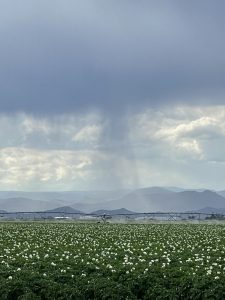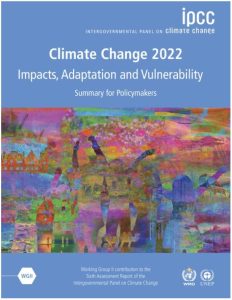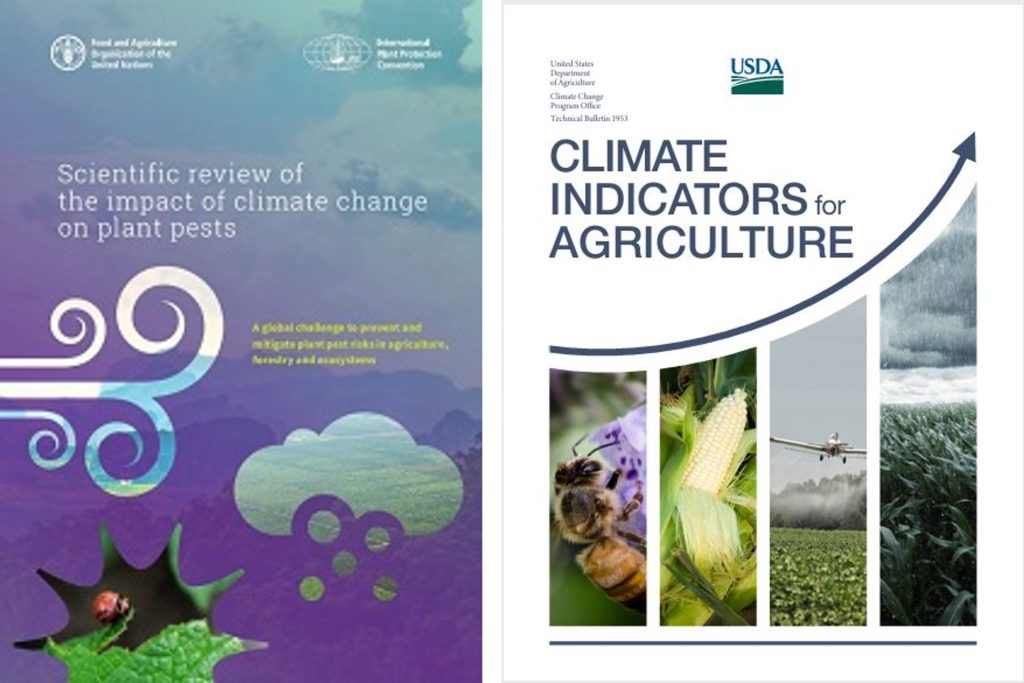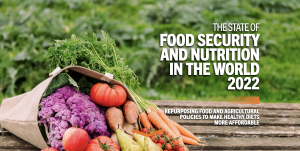Climate change impacts agricultural productivity and food security
Tara L. Moreau, University of British Columbia Botanical Garden, 6804 SW Marine Drive, Vancouver, BC Canada V6T 1Z4 (Tara.Moreau@ubc.ca)
A. Scott Denning, Department of Atmospheric Science, Colorado State University, Fort Collins, Colorado USA 80523 (Scott.Denning@colostate.edu)
Patrick F. Byrne, Department of Soil and Crop Sciences, Colorado State University, Fort Collins, Colorado USA 80523 (Patrick.Byrne@colostate.edu)
Gayle M. Volk, USDA-ARS National Laboratory for Genetic Resources Preservation, 1111 S. Mason St., Fort Collins, CO USA 80521 (Gayle.Volk@usda.gov)
Learning Objectives
Identify and explain climate-related stressors that might impact agricultural productivity and food security.
oUTLINE
- Introduction
- The science of climate change and the Intergovernmental Panel on Climate Change (IPCC)
- Climate change impacts on agricultural productivity
- Climate change impacts on food security
- Conclusions
- References
- Acknowledgments
1. introduction
Climate change has had past, present, and future impacts on plants, agriculture, and ex situ plant collection efforts. These impacts bring novel and complex challenges to the management and long-term stewardship of plant genetic resources, which are essential to agriculture and food systems (Volk et al., 2023). In this chapter, we explore climate-related abiotic (changes in temperature, water availability, weather events, etc.) and biotic stressors (insects, diseases, invasive species, etc.) that impact agriculture and food security.

2. the science related to climate change and the intergovernmental panel on climate change (IPCC)
Understanding how the climate system works and its complex impacts across local and global scales is best summarized, updated, and communicated by the United Nations Intergovernmental Panel on Climate Change (IPCC; IPCC, 2012; IPCC, 2022). Established in 1988, the IPCC prepares reports, projections, and strategies that summarize the science of climate change for policymakers, researchers, and the public.

The IPCC organizes their work relating to the science of climate change into three main working groups:
- Working Group 1 assesses the physical science that underpins climate change in the past, present, and future. Results from diverse datasets are compiled to create a complete global picture of the climate system and how it is changing.
- Working Group 2 assesses the impacts, adaptation, and vulnerabilities related to climate change. This includes worldwide and regional impacts of climate change on ecosystems and humans and how mitigation and adaptation can lead to a sustainable future.
- Working Group 3 focuses on climate change mitigation, and how to reduce greenhouse gas emissions and remove greenhouse gases from the atmosphere in both the near- and long-term.
IPCC reports include topics related to greenhouse gases, temperature changes in the air, land, and ocean, changes in precipitation, and extreme weather events. These reports bring together diverse data sets to help improve our understanding of climate change and to create a complete global picture of the climate system and how it is changing. Reports such as “Climate Change and Land” highlight a variety of topics including desertification, land degradation, sustainable land management, food security, and greenhouse gases (IPCC, 2019).
Video 1. Dr. Scott Denning, Colorado State University, provides an overview of the IPCC.
3. climate change impacts on agricultural productivity
Agricultural productivity around the world is impacted by climate change through both abiotic (non-living) and biotic (living) stressors (Volk et al., 2023). Future projections indicate that some agricultural systems will experience increased heat, rainwater, and CO2 levels that can improve yields; other agricultural systems will experience change such that the crops and specific cultivars that are currently cultivated can no longer be grown, or significant changes in cultivation practices will be needed (Hatfield and Dold, 2019; Sthapit et al., 2012). Regional declines in crop productivity can result from high temperatures and drought, as well as changes in plant-pathogen and plant-pest relationships (Altieri et al., 2015; Velásquez et al., 2018).
Understanding the impacts of climate change is critical, particularly in the regions where staple crops are produced (Jarvis et al., 2008). Changes in the timing of weather events including storms, hurricanes, and tornadoes, will undoubtedly affect crop growth and productivity.
3.1. abiotic stressors
Abiotic stressors such as extreme temperatures, drought, and salinity can significantly impact plant health, crop agriculture, and plant genetic resources. Planning for and understanding abiotic stress vulnerabilities is critical to maintaining climate-ready plant collections because these stressors can reduce crop productivity, limit plant distribution, and alter plant growth and development (Zhang et al., 2021).

Temperature
Climate change will affect both annual and seasonal temperatures, and this in turn affects plant phenology and health. In some cases, warmer conditions allow for earlier planting, longer growing seasons, and higher productivity. This could also help avoid droughts later in the season if crops could be harvested before dry weather sets in. However, the phenology of daylength-sensitive plants and plant-pollinator interactions might be affected by these changes (Irish and Volk, 2023). Sometimes plants can be grown in more northerly locations, and this also could affect flowering and other plant responses in daylength-sensitive plants. Hot summer days during sensitive growth stages could reduce pollen viability, as well as seed yield and quality (Hampton et al., 2016). Warm temperatures might also cause perennials to bloom earlier. These early flowers and young developing fruit could be severely damaged if subsequent frosts occur.
Higher temperatures increase plant transpiration and water uptake. Warmer nighttime temperatures and extreme high temperatures can be detrimental to plant growth by increasing respiration. Warmer winter temperatures might affect the number of chilling hours received in some locations, which then affects budbreak and bloom. Thus, bloom time and pollinator emergence could become temporally unaligned, thereby affecting fertilization and fruit/seed-set. Drought and higher temperatures also affect pollinators in other manners.
Water
Water availability and quality is a concern in both agricultural and conservation contexts. Seasonal changes in water availability will undoubtedly affect agricultural production. In some places, more frequent heavy rainfalls or snowfalls will occur, causing excess water that could lead to flooding. Coastal salt water intrusion due to sea level rise might directly impact plants by flooding or by increasing salinity of groundwater used for irrigation (Gibson et al., 2021). Drought conditions might deplete soil moisture; this will change the types of plants that can be grown or will require irrigation, which depends on having access to water from underground aquifers, lakes, rivers, or streams (Sthapit et al., 2012). Shorter winter seasons might reduce snowpack, which affects downstream water resources in the spring and summer. Changing precipitation might affect stream flows, riparian areas, and wetland function, which could in turn affect nearby agricultural areas by influencing water availability.
Video 2. A silent video animation illustrating the global change in summer precipitation between 1987 and 2095 (S. Denning).
Weather Events: Storms and Fire
Increased climatic variability and frequency of extreme weather such as droughts, floods, and high temperatures will impact food systems on a global scale (Altieri et al., 2015). In drought and extreme heat conditions, wildfire seasons are longer and the resulting fires are more intense. Wildfires produce smoke that reduces yields and productivity in farmed areas and also releases large quantities of carbon dioxide into the atmosphere. The U.S. Environmental Protection Agency provides a website with long-term data on climate change indicators, including wildfires.
Elevated CO2
Elevated CO2 might significantly increase agricultural productivity for some crop plants including wheat (Triticum aestivum), rice (Oryza sativa), soybean (Glycine max), maize (Zea mays), and millet (Cenchrus americanus), as well as sorghum (Sorghum bicolor) to a lesser extent (Hatfield et al., 2011). Higher CO2 levels could also increase weed growth, negatively impacting crop yields. However, there is considerable uncertainty about the long-term effects of CO2 fertilization on plant biomass at different ecological scales (Maschler et al., 2022).
3.2. biotic stressors
Plant pathogens, insect pests, and weed species will be affected in complex ways by a changing climate (Altieri et al., 2015; IPPC Secretariat, 2021; Irish and Volk, 2023). Warm temperatures and higher humidity affect the life cycles of pests and pathogens and the movement of vectors that transmit them (Sthapit et al., 2012). Warmer temperatures and longer growing seasons increase the duration of plants’ susceptibility to pests and disease and could increase the geographic distribution of pests, pathogens, and vectors. Shorter, warmer winters might extend the ranges of pests and diseases that were once limited by cold temperatures to higher latitudes or elevations, and could result in increased infection opportunities by larger pathogen populations (Altieri et al., 2015; Jarvis et al., 2008; Ma et al., 2016; Porter et al., 1991; Zeng et al., 2020). Pests and diseases expected to increase in occurrence or severity due to the effects of climate change include the emerald ash borer (Agrilus planipennis), desert locust (Schistocerca gregaria), late blight (Phytophthora infestans) of potato (Solanum tuberosum), and downy mildew (Plasmopara viticola) of grape (Vitis vinifera; IPPC Secretariat, 2021). In addition, the changing climate might affect the growth and development of invasive species, thus altering native plant habitats and in situ conservation opportunities (Hellman et al., 2008).

4. Climate change impacts on food security
Climate change and food security are linked through agricultural productivity (Altieri et al., 2015; Wheeler and von Braun, 2013). The United Nations Food and Agricultural Organization (FAO) states that “food security exists when all people, at all times, have physical and economic access to sufficient, safe and nutritious food that meets their dietary needs and food preferences for an active and healthy life” (FAO et al., 2022). This includes food availability, food access, utilization, and stability. Current agricultural practices such as monocultural plantings can put food production at risk, particularly for crops that are not well-adapted to changing climatic conditions. The homogeneity of monoculture can threaten food production due to increased vulnerabilities to biotic stresses (Heinemann et al., 2014). Responses to climate change threats relating to agriculture must address needs in vulnerable regions of the world since the impacts of food insecurity are highest in these areas and many of these cultures rely on local food systems (Queiroz et al., 2021). Furthermore, primary carbon sinks and regions of high biodiversity are often located in these regions; these critical ecosystems could be lost to deforestation if it becomes necessary to convert more land for agricultural production (Loboguerrero et al., 2019; Queiroz et al., 2021).
The UN Food and Agriculture Organization annually publishes international assessments of the impact of climate change on food security and nutrition in “The State of Food Security and Nutrition in the World” (FAO et al., 2022). These reports are part of the State of the World series, which compiles scientific information for policy makers.

5. Conclusions
Climate change is expected to affect a variety of abiotic stressors—including changes in temperature and water availability, frequency of storms and wildfires, and increased CO2 levels—that directly impact plant development and crop production. The abiotic effects of climate change additionally affect the biotic organisms that have significant relationships with crops: pollinators, insect pests, pathogens, and competing non-native plants. Any combination of these stressors can jeopardize the state of local and global food security. It is imperative that agricultural processes adapt to these changing conditions before we lose the crops that provide food, fiber, fuel, and other essential resources.
6. References
Altieri M, Nicholls CI, Henao A, Lana MA. 2015. Agroecology and the design of climate change-resilient farming systems. Agronomy for Sustainable Development 35:869-890. DOI: 10.1007/s13593-015-0285-2
FAO, IFAD, UNICEF, WFP, WHO. 2022. The State of Food Security and Nutrition in the World 2022. Repurposing food and agricultural policies to make healthy diets more affordable. Food and Agriculture Organization of the UNited Nations, Rome. DOI: 10.4060/cc0639en
Gibson N, McNulty S, Miller C, Gavazzi M, Worley E, Keesee D, Hollinger D. 2021. Identification, mitigation, and adaptation to salinization on working lands in the U. S. southeast. U.S. Forest Service General Technical Report SRS-259. DOI: 10.2737/SRS-GTR-259
Hampton JG, Conner AJ, Boelt B, Chastain TG, Rolston P. 2016. Climate change: Seed production and options for adaptation. Agriculture 6:33. DOI: 10.3390/agriculture6030033
Hatfield JL, Boote KJ, Kimball BA, Ziska LH, Izaurralde RC, Ort D, Thomson AM, Wolfe D. 2011. Climate impacts on agriculture: Implications for crop production. Agronomy Journal 103:351-370. DOI: 10.2134/agronj2010.0303
Hatfield JL, Dold C. 2019. Water-use efficiency: Advances and challenges in a changing climate. Frontiers in Plant Science 10:103. DOI: 10.3389/fpls.2019.00103
Hellman JJ, Byers JE, Bierwagen BG, Dukes JS. 2008. Five potential consequences of climate change for invasive species. Conservation Biology 22:534-543. DOI: 10.1111/j.1523-1739.2008.00951.x
Heinemann JA, Massaro M, Coray DS, Agapito-Tenfen SZ, Wen JD. 2014. Sustainability and innovation in staple crop production in the US Midwest. International Journal of Agricultural Sustainability 12:71-88. DOI: 10.1080/14735903.2013.806408
IPCC. 2012. Glossary of terms. In: Managing the Risks of Extreme Events and Disasters to Advance Climate Change Adaptation [Field CB, Barros V, Stocker TF, Qin D, Dokken DJ, Ebi KL, Mastrandrea MD, Mach KJ, Plattner GK, Allen SK, Tignor M, Midgley PM (eds.)]. A Special Report of Working Groups I and II of the Intergovernmental Panel on Climate Change (IPCC). Cambridge University Press, Cambridge, UK. pp. 555-564. Available from: ipcc.ch/report/managing-the-risks-of-extreme-events-and-disasters-to-advance-climate-change-adaptation
IPCC. 2019. Climate Change and Land: an IPCC special report on climate change, desertification, land degradation, sustainable land management, food security, and greenhouse gas fluxes in terrestrial ecosystems [P.R. Shukla, J. Skea, E. Calvo Buendia, V. Masson-Delmotte, H.-O. Pörtner, D. C. Roberts, P. Zhai, R. Slade, S. Connors, R. van Diemen, M. Ferrat, E. Haughey, S. Luz, S. Neogi, M. Pathak, J. Petzold, J. Portugal Pereira, P. Vyas, E. Huntley, K. Kissick, M. Belkacemi, J. Malley, (eds.)]. Cambridge University Press, Cambridge, UK. Available from: ipcc.ch/srccl
IPCC. 2022. The Intergovernmental Panel on Climate Change. Geneva , Switzerland. Accessed on 28 December 2022. Available from: ipcc.ch
Irish BM, Volk GM. 2023. Climate change affects plant interactions with pollinators, pathogens, and pests. In: Volk GM, Moreau TL, Byrne PF. Conserving and Using Climate-Ready Plant Collections. Fort Collins, Colorado: Colorado State University. Available from: colostate.pressbooks.pub/climatereadyplantcollections/chapter/pollinators-pathogens-and-pests
IPPC Secretariat. 2021. Scientific review of the impact of climate change on plant pests – A global challenge to prevent and mitigate plant pest risks in agriculture, forestry and ecosystems. Rome. FAO on behalf of the IPPC Secretariat. DOI: 10.4060/cb4769en
Jarvis A, Lane A, Hijmans RJ. 2008. The effect of climate change on crop wild relatives. Agriculture, Ecosystems and Environment 126:13-23. DOI: 10.1016/j.agee.2008.01.013
Loboguerrero AM, Campbell BM, Cooper PJM, Hansen JW, Rosenstock T, Wollenberg E. 2019. Food and earth systems: Priorities for climate change adaptation and mitigation for agriculture and food systems. Sustainability 11:1372. DOI: 10.3390/su11051372
Ma L, Kong X, Qiao J, An F, Hu X, Xu X. 2016. Overwintering of Puccinia striiformis f. tritici on winter wheat at varying altitudes in Gansu and Qinghai Provinces. Plant Disease 100:1138-1145. DOI: 10.1094/PDIS-09-15-1112-RE
Maschler J, Bialic-Murphy L, Wan J, Andresen LC, Zohner CM, et al. 2022. Links across ecological scales: Plant biomass responses to elevated CO2. Global Change Biology 28:6115-6134. DOI: 10.1111/gcb.16351
Porter J, Parry M, Carter T. 1991. The potential effects of climatic change on agricultural insect pests. Agricultural and Forest Meteorology 57:221-240. DOI: 10.1016/0168-1923(91)90088-8
Queiroz C, Norström AV, Downing A, et al. 2021. Investment in resilient food systems in the most vulnerable and fragile regions is critical. Nature Food 2:546-551. DOI: 10.1038/s43016-021-00345-2
Sthapit BR, Ramanatha Rao V, Sthapit SR. 2012. Tropical Fruit Tree Species and Climate Change. Bioversity International, New Delhi, India. Available from: bioversityinternational.org/e-library/publications/detail/tropical-fruit-tree-diversity/
Velásquez AC, Castroverde CDM, He SY. 2018. Plant-pathogen warfare under changing climate conditions. Current Biology 28:R619-R634. DOI: 10.1016/j.cub.2018.03.054
Volk GM, Carver D, Irish BM, Marek L, Frances A, Greene S, Khoury CK, Bamberg J, del Rio A, Warburton ML, Bretting PK. 2023. Safeguarding plant genetic resources in the United States during global climate change. Crop Science 1-23. https://doi.org/10.1002/csc2.21003
Walsh MK, Backlund P, Buja L, DeGaetano A, Melnick R, Prokopy L, Takle E, Todey E, Ziska L. 2020. Climate Indicators for Agriculture. USDA Technical Bulletin 1953. Washington, DC. DOI: 10.25675/10217/210930
Wheeler T, von Braun J. 2013. Climate change impacts on global food security. Science 341:508-513. DOI: 10.1126/science.1239402
Zeng J, Liu Y, Zhang Y, Liu J, Jiang Y, Wyckhuys KAG, et al. 2020. Global warming modifies long-distance migration of an agricultural insect pest. Journal of Pest Science 93:569-581. DOI: 10.1007/s10340-019-01187-5
Zhang H, Zhu J, Zhizhong G, Zhu JK. 2021. Abiotic stress responses in plants. Nature Reviews Genetics 23:104-119. DOI: 10.1038/s41576-021-00413-0
7. acknowledgments
Citation: Moreau TL, Denning AS, Byrne PF, Volk GM. 2023. Climate change impacts agricultural productivity and food security. In: Volk GM, Moreau TL, Byrne PF. Conserving and Using Climate-Ready Plant Collections. Fort Collins, Colorado: Colorado State University. Date accessed. Available from: https://colostate.pressbooks.pub/climatereadyplantcollections/chapter/agricultural-productivity-and-food-security/
This eBook chapter was developed through a collaboration among USDA-Agricultural Research Service, Colorado State University, and the University of British Columbia Botanic Garden, with additional funding from the USDA-NIFA-Higher Education Challenge Grant (2020-70003-303930).
Editor: Katheryn Chen
Videography: CSU Online
conservation of plant genetic resources outside their natural habitat
the organs and tissues (seeds, fruits, cuttings, pollen, tissue cultures, etc.) by which plants can be propagated (synonymous with plant germplasm)
the network of activities connecting people to their food
an interconnected system consisting of five major components: the atmosphere, the hydrosphere, the cryosphere, the land surface, and the biosphere
in a climate change context, actions that reduce or prevent greenhouse gas emissions or that lower the amount of greenhouse gases in the atmosphere
in a climate change context, taking action to prepare for and adjust to both the current and projected impacts of climate change
a crop variety produced by scientific breeding or farmer selection methods
plant collections that are resilient to the changing environment, with particular reference to climate-change
cyclic and seasonal aspects of plant growth and development (such as flowering time)
conserving plant genetic resources on-farm or within ecosystems

